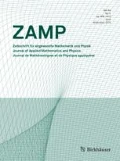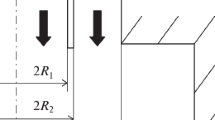Abstract
The evolution of a cloud of particles in a compressible fluid can be modeled with a Vlasov–Fokker–Planck equation for the distribution function of the particles coupled with Navier–Stokes or Euler equations for the density and velocity of the fluid. Formal calculations have established the convergence of solution to the mesoscopic model to solutions to the macroscopic Navier–Stokes or Euler model coupled with a Smoluchowski equation as the ratio of the settling time for the microscopic velocity fluctuation of the particles to the characteristic macroscopic time scale goes to zero. This paper provides a rigorous asymptotic analysis for a homogeneous mesoscopic fluid–particle interaction model for particles dispersed in a compressible fluid is provided for the bubbling regime. A relative entropy inequality for a mixed hyperbolic/parabolic system of equations is employed.
Similar content being viewed by others
References
Amsden, A.A.: Kiva-3V Release 2, Improvements to Kiva-3V. Tech. Report, Los Alamos National Laboratory (1999)
Amsden, A.A., O’Rourke, P.J., Butler, T.D.: Kiva-2, A computer program for chemical reactive flows with sprays. Tech. Report, Los Alamos National Laboratory (1989)
Ballew, J.: Vanishing viscosity solutions for the Navier–Stokes–Smoluchowski system for particles in a compressible fluid (2016) Preprint
Ballew, J., Trivisa, K.: Suitable weak solutions and low stratification singular limit for a fluid particle interaction model. Q. Appl. Math. 70(3), 469–494 (2012)
Ballew, J., Trivisa, K.: Viscous and inviscid models in fluid-particle interaction. Commun. Inf. Syst. 13(1), 45–78 (2013)
Ballew, J., Trivisa, K.: Weakly dissipative solutions and weak-strong uniqueness for the Navier–Stokes–Smoluchowski system. Nonlinear Anal. 91, 1–19 (2013)
Baranger, C., Boudin, L., Jabin, P.-E., Mancini, S.: A modeling of biospray for the upper airways. In: CEMRACS 2004—mathematics and applications to biology and medicine, ESAIM Proc., vol. 14, EDP Sci., Les Ulis, 2005, pp. 41–47 (electronic)
Berres, S., Bürger, R., Karlsen, K.H., Tory, E.M.: Strongly degenerate parabolic-hyperbolic systems modeling polydisperse sedimentation with compression. SIAM J. Appl. Math. 64(1), 41–80 (2003)
Bouchut, F.: Construction of bgk models with a family of kinetic entropies for a given system of conservation laws. J. Stat. Phys. 95(1), 113–170 (1999)
Carrillo, J.A., Karper, T., Trivisa, K.: On the dynamics of a fluid-particle interaction model: the bubbling regime. Nonlinear Anal. 74(8), 2778–2801 (2011)
Carrillo, J.A., Goudon, T.: Stability and asymptotic analysis of a fluid-particle interaction model. Commun. Partial Diff. Equ. 31(7–9), 1349–1379 (2006)
Christoforou, C., Tzavaras, A.E.: Relative entropy for hyperbolic-parabolic systems and application to the constitutive theory of thermoviscoelasticity. Arch. Ration. Mech. Anal. 229(1), 1–52 (2018)
Dafermos, C.M.: Hyperbolic conservation laws in continuum physics, third ed., Grundlehren der Mathematischen Wissenschaften [Fundamental Principles of Mathematical Sciences], vol. 325, Springer, Berlin (2010)
Feireisl, E., Novotný, A., Sun, Y.: Suitable weak solutions to the Navier–Stokes equations of compressible viscous fluids. Indiana Univ. Math. J. 60(2), 611–631 (2011)
Goudon, T., Jabin, P.-E., Vasseur, A.: Hydrodynamic limit for the Vlasov–Navier–Stokes equations. I. Light particles regime. Indiana Univ. Math. J. 53(6), 1495–1515 (2004)
Kružkov, S.N.: First order quasilinear equations with several independent variables. Mat. Sb. (N.S.) 81(123), 228–255 (1970)
Mellet, A., Vasseur, A.: Global weak solutions for a Vlasov–Fokker–Planck/Navier–Stokes system of equations. Math. Models Methods Appl. Sci. 17(7), 1039–1063 (2007)
Mellet, A., Vasseur, A.: Asymptotic analysis for a Vlasov–Fokker–Planck/compressible Navier–Stokes system of equations. Commun. Math. Phys. 281(3), 573–596 (2008)
Williams, F.A.: Spray combustion and atomization. Phys. Fluids 1(6), 541–545 (1958)
Williams, F.A.: Combustion Theory: The Fundamental Theory of Chemically Reacting Flow Systems, 2nd edn. Benjamin/Cummings Pub, Menlo Park, CA (1985)
Author information
Authors and Affiliations
Corresponding author
Additional information
Publisher's Note
Springer Nature remains neutral with regard to jurisdictional claims in published maps and institutional affiliations.
J. B. gratefully acknowledges support from the National Science Foundation under Grant DMS-1401732.
Rights and permissions
About this article
Cite this article
Ballew, J. Asymptotic analysis for a homogeneous bubbling regime Vlasov–Fokker–Planck/Navier–Stokes system. Z. Angew. Math. Phys. 71, 131 (2020). https://doi.org/10.1007/s00033-020-01359-9
Received:
Revised:
Published:
DOI: https://doi.org/10.1007/s00033-020-01359-9




